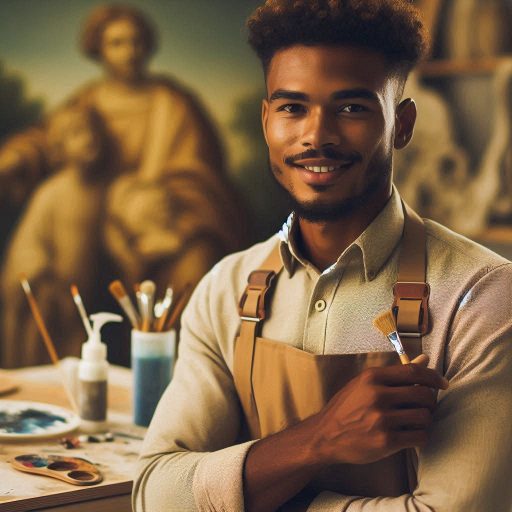Introduction
An art conservator or restorer is responsible for preserving and maintaining cultural heritage.
Their job involves restoring damaged art and ensuring its longevity.
They work with various materials such as paintings, sculptures, and textiles, using techniques that prevent further deterioration.
Each project requires a careful understanding of the art’s historical significance and the materials used by the artist.
What an Art Conservator/Restorer Does
Art conservators/restorers carefully assess the condition of artwork to determine the appropriate treatment.
They clean, repair, and stabilize fragile pieces, often using both traditional methods and modern technologies.
Their goal is to preserve the original integrity of the piece without altering its historical value.
Each restoration involves detailed research, meticulous planning, and precise execution to ensure that the art remains true to its original form.
Importance of Art Conservation and Restoration
Art conservation is crucial for preserving cultural heritage.
Without proper care, art can deteriorate, leading to the loss of valuable history and stories.
Conservators help future generations appreciate the beauty and significance of these works.
They ensure that art remains intact for education, inspiration, and enjoyment.
Art is not just a visual experience; it connects us to our past and reflects our collective human identity.
Through restoration, damaged or faded pieces are brought back to life.
This process preserves the artist‘s original vision and message.
By maintaining art, conservators keep history alive for museums, galleries, and public spaces.
Their work ensures that cultural treasures are preserved and appreciated for many years to come.
Art conservation and restoration are essential in maintaining our global cultural legacy.
Education and Training
Art conservators/restorers typically undergo extensive education and training to prepare for their career in preserving and restoring artworks.
The following details the educational background required and the practical experience needed to excel in this field.
Transform Your Career Today
Unlock a personalized career strategy that drives real results. Get tailored advice and a roadmap designed just for you.
Start NowEducational Background
In order to become an art conservator/restorer, individuals usually need to obtain a bachelor’s degree in a relevant field such as art history, chemistry, conservation science, or fine arts.
Some programs also require a master’s degree in art conservation or a related discipline.
This educational background provides students with the foundational knowledge needed to understand the materials and techniques used in creating various artworks.
Art history courses help conservators understand the context of different artistic movements and styles, while chemistry and conservation science courses provide insight into the chemical properties of art materials and the mechanisms of deterioration.
Fine arts courses may also be beneficial in developing practical skills related to painting, sculpture, or other artistic mediums.
Internships and Practical Training
In addition to formal education, internships and practical training are crucial for aspiring art conservators/restorers.
Practical experience allows individuals to gain hands-on experience working with actual artworks and practicing conservation techniques under the supervision of experienced professionals.
Internships in conservation labs or museums provide valuable opportunities to work with diverse collections and learn about the specific challenges associated with preserving different types of artworks.
These internships may involve tasks such as cleaning, documentation, condition assessments, and actual conservation treatments.
Practical training programs often require students to complete a certain number of hours working in conservation labs or museums to fulfill degree requirements.
This hands-on experience is essential for developing the skills and expertise needed to work independently as an art conservator/restorer.
Overall, the combination of formal education and practical training equips art conservators/restorers with the knowledge, skills, and experience necessary to preserve and restore artworks for future generations to enjoy.
Read: Top Art Conservation Programs in the USA
Daily Tasks
As an art conservator/restorer, my day typically starts with examining and documenting artworks.
This involves carefully inspecting pieces to assess their condition and create detailed records.
After the initial examination, I move on to the cleaning, repairing, and restoring process.
This is where my specialized tools and techniques come into play, allowing me to carefully and skillfully work on each artwork.
Collaboration is a key aspect of my daily tasks.
I frequently work with other professionals, such as curators and scientists, to gain insights into the historical and scientific aspects of the artworks I am restoring.
Examination and Documentation of Artworks
- Inspecting artworks for signs of damage or deterioration
- Recording detailed notes and observations
- Creating reports and documentation for future reference
Cleaning, Repairing, and Restoring Artworks
- Using specialized tools like brushes, solvents, and microscopes
- Repairing tears, cracks, and other damages carefully
- Applying varnishes and other protective coatings
Collaborating with Other Professionals
- Working closely with curators to understand the historical context of artworks
- Consulting scientists for analysis of materials and techniques used in artworks
- Participating in team meetings to discuss progress and share expertise
Overall, each day as an art conservator/restorer is a dynamic combination of meticulous examination, skilled restoration work, and meaningful collaboration with fellow experts in the field.
Transform Your Career Today
Unlock a personalized career strategy that drives real results. Get tailored advice and a roadmap designed just for you.
Start NowIt is a fulfilling and challenging profession that allows me to protect and preserve our cultural heritage for future generations to enjoy.
Read: Must-Visit Art and Design Schools in the USA
Challenges Faced
As an art conservator/restorer, there are several challenges that I face on a daily basis.
These challenges test my skills, patience, and dedication to preserving and restoring artwork for future generations.
Dealing with fragile or damaged artwork
One of the most significant challenges I face is working with delicate and fragile artworks that require delicate handling and treatment.
Whether it’s a torn canvas, faded paint, or a sculpture that’s missing pieces, each restoration project comes with its unique set of difficulties.
Balancing conservation ethics with aesthetic considerations
Another challenge I face is finding the balance between following strict conservation ethics and satisfying aesthetic considerations.
It can be challenging to make decisions on how to best restore an artwork while preserving its original integrity and historical value.
Managing time and resources effectively
Time and resources are always a challenge for art conservators/restorers.
With multiple projects on hand, it’s essential to prioritize tasks, set deadlines, and allocate resources efficiently to ensure that each artwork receives the care and attention it deserves.
Despite these challenges, being an art conservator/restorer is a rewarding and fulfilling profession.
The satisfaction of bringing a damaged or deteriorating artwork back to its former glory is what drives me to overcome these obstacles every day.
Read: Career Paths for Graduates in Art and Design

Specializations within the field
When it comes to being an art conservator/restorer, there are various specializations within the field that professionals can choose to focus on.
These specializations help conservators hone their skills and expertise in specific areas of art conservation.
Different types of materials and techniques
One of the main specializations within the field of art conservation is focusing on different types of materials and techniques used in artworks.
For example, some conservators may specialize in the conservation of paintings, while others may focus on sculptures or textiles.
Each type of material requires a unique set of skills and knowledge to properly preserve and restore the artwork.
Conservation of specific art periods or styles
Another specialization within the field is the conservation of specific art periods or styles.
Conservators may choose to specialize in preserving artworks from a particular historical period, such as the Renaissance or Baroque era.
Transform Your Career Today
Unlock a personalized career strategy that drives real results. Get tailored advice and a roadmap designed just for you.
Start NowThis specialization allows conservators to develop a deep understanding of the materials and techniques used during that time, helping them to better care for and restore artworks from that period.
Emerging trends and technologies in conservation
As technology continues to advance, there are emerging trends and technologies in the field of art conservation that conservators can specialize in.
For example, some conservators may focus on digital imaging techniques to analyze and document artworks, while others may specialize in the use of nanomaterials for conservation purposes.
By staying up-to-date on the latest trends and technologies, conservators can enhance their skills and offer innovative solutions for preserving and restoring artworks.
In fact, there are various specializations within the field of art conservation that professionals can pursue to further their expertise and knowledge.
Whether focusing on specific materials and techniques, art periods or styles, or emerging trends and technologies, each specialization offers unique opportunities for conservators to excel in their field.
By choosing a specialization that aligns with their interests and passions, conservators can make a significant impact in preserving our cultural heritage for future generations.
Read: Skills Required for Art Conservation and Restoration
Work Environment
As an art conservator/restorer, the work environment plays a crucial role in the conservation process.
Conservation Labs, Museums, Galleries, or Private Studios
Conservators can be found working in various settings such as conservation labs in museums, galleries, or private studios.
Each environment offers unique challenges and opportunities for conservators to work on a wide range of art pieces.
Working Conditions
Conservators must work in controlled environments where temperature, humidity, and lighting are carefully monitored.
These conditions are essential to ensure the preservation of the artworks and prevent any damage during the restoration process.
Importance of Teamwork and Communication with Colleagues
Collaboration with colleagues is vital in the field of art conservation.
Conservators often work as part of a team, sharing insights, techniques, and knowledge to achieve the best results.
Effective communication with colleagues helps in problem-solving and decision-making during the restoration process.
Conservators rely on each other‘s expertise and feedback to ensure the proper care and preservation of the artworks.
Personal skills and qualities
Being an art conservator/restorer requires a unique set of personal skills and qualities that are essential for success in this field.
Let’s take a look at some of the key attributes that are crucial for an art conservator/restorer:
Attention to detail and precision
An art conservator must have exceptional attention to detail.
Transform Your Career Today
Unlock a personalized career strategy that drives real results. Get tailored advice and a roadmap designed just for you.
Start NowEvery brushstroke and texture requires meticulous observation.
Precision is vital when repairing delicate artworks.
Even the slightest error can affect the artwork’s integrity.
Conservators use specialized tools to ensure every detail is handled with care.
They analyze materials and techniques with accuracy.
Each conservation project demands a keen eye for fine details.
This skill helps prevent further damage and maintains historical value.
Attention to detail ensures that the final restoration aligns with the original artwork.
Patience and perseverance
Art conservation often involves slow, methodical work.
Conservators must possess immense patience.
Some projects can take months or even years to complete.
Perseverance is essential when facing complex restoration challenges.
The process can be tedious, requiring careful handling and repeated adjustments.
Conservators need to remain focused, even when progress seems slow.
This patience helps them address intricate issues without rushing.
Perseverance ensures that every aspect of the artwork receives the necessary attention.
These qualities help achieve the best possible results in preserving art.
Problem-solving and critical thinking skills
Conservators face various challenges in their work.
Problem-solving skills are crucial for addressing unexpected issues.
Each artwork presents unique restoration problems that require creative solutions.
Transform Your Career Today
Unlock a personalized career strategy that drives real results. Get tailored advice and a roadmap designed just for you.
Start NowCritical thinking helps conservators evaluate different approaches to conservation.
They must assess the condition of materials and choose the best methods for repair.
Analyzing the artwork’s history and previous treatments aids in making informed decisions.
Effective problem-solving ensures that each restoration is both effective and respectful to the original piece.
These skills are key to overcoming obstacles and achieving successful outcomes.
Uncover the Details: Understanding the Basics of Color Theory in Art
Professional Development
Continuing education and training opportunities
As an art conservator/restorer, continuing education and training opportunities are vital to staying current in the field.
Attending workshops and conferences to learn new techniques and best practices.
‘Participating in hands-on training sessions to hone skills and stay updated on industry standards.
Networking with other conservation professionals
Networking with other conservation professionals is also crucial for growth and knowledge exchange.
Joining professional organizations like the American Institute for Conservation (AIC) to connect with peers.
Attending local meetups and events to discuss challenges and share experiences with fellow professionals.
Staying updated on new research and developments in the field
Staying updated on new research and developments in the field is key to providing top-notch restoration services.
Reading academic journals and publications to understand the latest trends and breakthroughs in conservation.
Participating in online forums and discussion groups to engage with experts and stay informed on industry news.
By actively pursuing opportunities for professional development, art conservators can ensure they are equipped with the knowledge and skills needed to preserve our cultural heritage for future generations.
Conclusion
Art conservation and restoration play a crucial role in preserving our cultural heritage.
These professionals protect and repair artworks to ensure their longevity.
Their work maintains the historical and aesthetic value of pieces for future generations.
The dedication of art conservators and restorers is evident in their meticulous approach.
Transform Your Career Today
Unlock a personalized career strategy that drives real results. Get tailored advice and a roadmap designed just for you.
Start NowThey use specialized techniques and tools to address deterioration and damage.
Their expertise in chemistry, art history, and craftsmanship is essential to their success.
Each project requires careful assessment and precise intervention.
Art conservators and restorers often work behind the scenes.
Their contributions may go unnoticed, but their impact is profound.
By preserving artworks, they safeguard our collective history and culture.
Their efforts ensure that future generations can experience and learn from our artistic legacy.
Appreciating the work of these professionals is vital.
Their commitment to art conservation and restoration upholds our cultural heritage.
They bridge the past and present, allowing us to connect with history through preserved artworks.
Recognizing their expertise and dedication enhances our understanding of the importance of preserving cultural treasures.
In summary, art conservators and restorers are guardians of our artistic and cultural history.
Their work requires skill, patience, and deep knowledge.
Let us acknowledge and value their efforts in maintaining the legacy of our artistic heritage.




